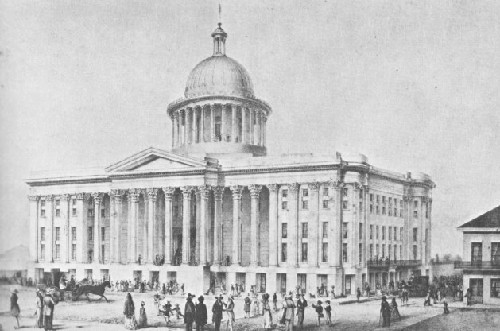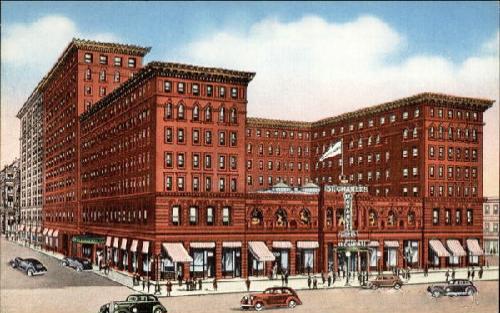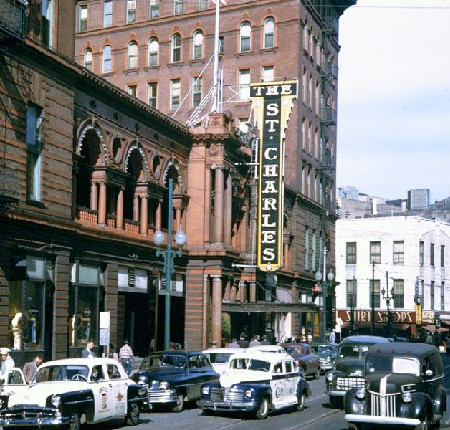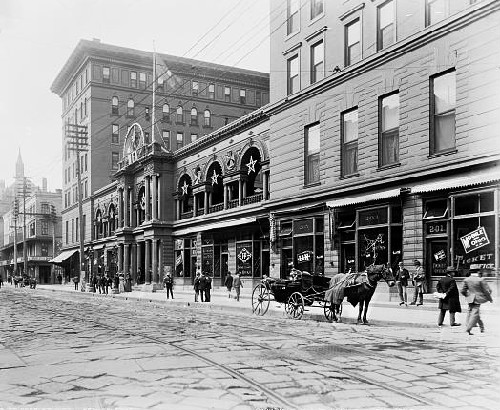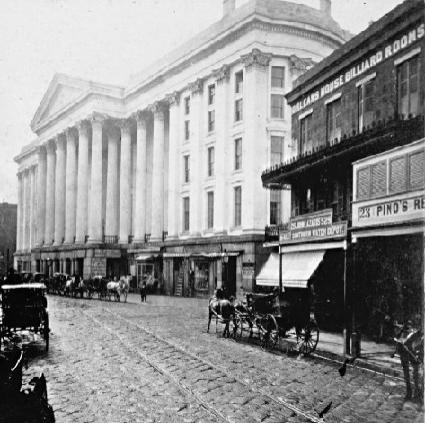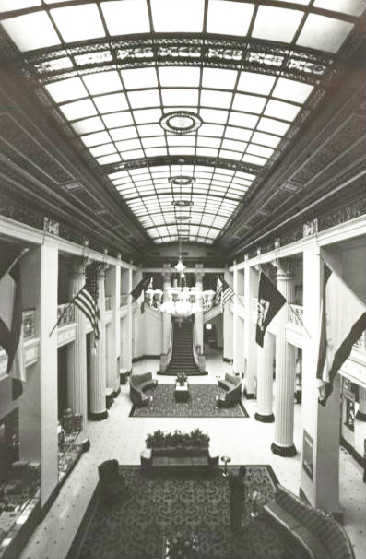| "The Finest Piece of Architecture in the New World" The Old St. Charles Hotel |
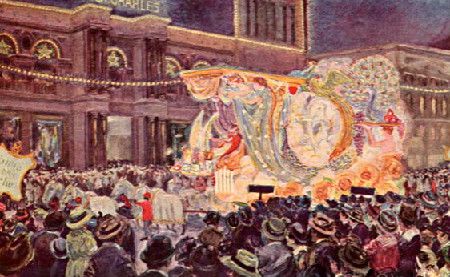
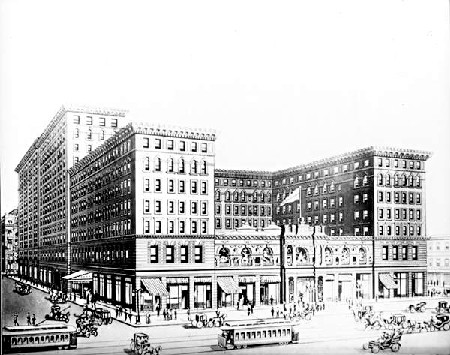
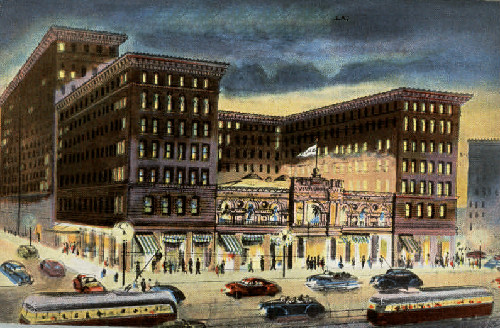
| Sketch of the first St. Charles Hotel, completed in 1837 and destroyed by fire in 1851. The second building was almost identical, but without the accompanying crown of the great cupola. |
| The second St. Charles Hotel building stood from 1852 to 1894, when it met the same fate as the first building. |
The spectacular fire which took the first St. Charles Hotel in 1851, also, destroyed the First
Methodist Church, First Presbyterian Church and 15 other buildings. There were some
injuries, but, amazingly, no fatalities. This seems remarkable when you consider that the
hotel had over 800 guests in residence at the time of the fire.
The destruction of the second St. Charles in 1894 was contained to the hotel and adjacent
buildings, however, four people perished and many more were injured.
Methodist Church, First Presbyterian Church and 15 other buildings. There were some
injuries, but, amazingly, no fatalities. This seems remarkable when you consider that the
hotel had over 800 guests in residence at the time of the fire.
The destruction of the second St. Charles in 1894 was contained to the hotel and adjacent
buildings, however, four people perished and many more were injured.
| The third St. Charles Hotel, constructed immediately after the fire in 1894, left behind the Greek Revival architecture of its past and went to a Breaux Arts design. |
| St. Charles Hotel, 1908 |
The following ad appeared in "The Picayune's Guide to New Orleans" in 1904:
Visit Quaint, Historic New Orleans and the New St. Charles Hotel
It is one of the latest, largest and best hotels in the country
It is the only fireproof hotel in the city
It is steam-heated and lighted throughout with electricity
The drinking water is filtered, distilled and serated; it and the ice made
from it on the premises are absolutely pure
The Colonnade and Covered Roof Garden offer a delightful promenade
The Turkish and Russian baths are among the finest in the country, built of
marble and luxuriously fitted up, with experienced massage operators in
attendance
The hotel is kept on both the American and European plans
Visit Quaint, Historic New Orleans and the New St. Charles Hotel
It is one of the latest, largest and best hotels in the country
It is the only fireproof hotel in the city
It is steam-heated and lighted throughout with electricity
The drinking water is filtered, distilled and serated; it and the ice made
from it on the premises are absolutely pure
The Colonnade and Covered Roof Garden offer a delightful promenade
The Turkish and Russian baths are among the finest in the country, built of
marble and luxuriously fitted up, with experienced massage operators in
attendance
The hotel is kept on both the American and European plans
| Above, 1930's; below, a Mardi Gras parade passes in front of the St. Charles, date unknown. |
| St. Charles Hotel, 1940's |
The St. Charles Hotel continued to be a gathering place for
politicians, celebrities, royalty and movers and shakers in the
business world into the middle of the 20th century. Presidents
McKinley, Roosevelt and Taft were among the hotel's guests.
However, by the 1970's, the hotel had suffered a decline, unable to
keep up with the many new modern hotels cropping up in the city.
The majestic old St. Charles finally closed its doors and the building
was demolished in 1974.
This made my Dad a little sad, since his first job - at the tender age
of 14 - had been as a bellboy at the grand St. Charles Hotel.
politicians, celebrities, royalty and movers and shakers in the
business world into the middle of the 20th century. Presidents
McKinley, Roosevelt and Taft were among the hotel's guests.
However, by the 1970's, the hotel had suffered a decline, unable to
keep up with the many new modern hotels cropping up in the city.
The majestic old St. Charles finally closed its doors and the building
was demolished in 1974.
This made my Dad a little sad, since his first job - at the tender age
of 14 - had been as a bellboy at the grand St. Charles Hotel.
| The St. Charles, 1940's |
| The link to this page is: http://old-new-orleans.com/NO_StCharlesHotel.html 1920 Photo of St. Charles Hotel Photos: Some Old New Orleans Hotels Back to Old New Orleans Whispers - Home |
| Many thanks to James Fiegler who shared this photograph of the St. Charles Hotel lobby taken in 1973, the year before it closed. Even in its final days, it was still beautiful. |
There's no way to overstate the importance of the role the majestic St. Charles Hotel played
in the evolution and history of the city. For 135 years, one of the three incarnations of the
historic hotel loomed over St. Charles Avenue, two blocks off of Canal Street. When
construction started on the first building in 1835, the "American sector" of the city (the land
above Canal Street) wasn't much more than a wilderness. But, with the completion of what
one British travel writer called "the finest piece of architecture in the New World," the
neighborhood around the magnificent hotel flourished. From John Kendall's "History of New
Orleans," published in 1922:
"The St. Charles was the first large building erected above Canal Street. Within its walls,
over the next hundred years, half the business of the city was to be transacted and half the
history of the state of Louisiana was to be written. The hotel was designed by noted architect
James Gallier. It was the grandest hotel in the South, in fact, the first of all great American
hotels. Oakey Hall, who later became the mayor of New York, said of it, 'Set the St. Charles
down in St. Petersburg, and you would think it a palace; in Boston, you would christen it a
college; in London, it would remind you of an exchange; in New Orleans, it is all three.' Mr.
Hall was unable to contain his surprise at finding in the city of New Orleans something far
grander than anything New York could boast of.
"The hotel had a magical effect upon the quarter of the city in which it stood. It rapidly built
up the First District, known as the American sector. Around it, as a center, gathered the
traffic and trade of the city. Churches sprang up near it; stores and dwellings spread out in
every direction. St. Charles Street, which did not extend far above the hotel, became the
most animated thoroughfare in the United States."
in the evolution and history of the city. For 135 years, one of the three incarnations of the
historic hotel loomed over St. Charles Avenue, two blocks off of Canal Street. When
construction started on the first building in 1835, the "American sector" of the city (the land
above Canal Street) wasn't much more than a wilderness. But, with the completion of what
one British travel writer called "the finest piece of architecture in the New World," the
neighborhood around the magnificent hotel flourished. From John Kendall's "History of New
Orleans," published in 1922:
"The St. Charles was the first large building erected above Canal Street. Within its walls,
over the next hundred years, half the business of the city was to be transacted and half the
history of the state of Louisiana was to be written. The hotel was designed by noted architect
James Gallier. It was the grandest hotel in the South, in fact, the first of all great American
hotels. Oakey Hall, who later became the mayor of New York, said of it, 'Set the St. Charles
down in St. Petersburg, and you would think it a palace; in Boston, you would christen it a
college; in London, it would remind you of an exchange; in New Orleans, it is all three.' Mr.
Hall was unable to contain his surprise at finding in the city of New Orleans something far
grander than anything New York could boast of.
"The hotel had a magical effect upon the quarter of the city in which it stood. It rapidly built
up the First District, known as the American sector. Around it, as a center, gathered the
traffic and trade of the city. Churches sprang up near it; stores and dwellings spread out in
every direction. St. Charles Street, which did not extend far above the hotel, became the
most animated thoroughfare in the United States."
| I appreciate John Sconza sharing this photo of his dad's St. Charles Hotel bell boy button. His father, Anthony Sconza, worked at the hotel in the 1930's. I'm especially happy to have this picture, because my dad worked as a bell boy at the hotel at about the same time, but I'd never seen the button he wore. |
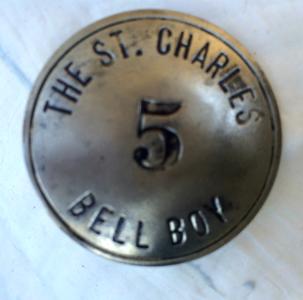
| ..... |
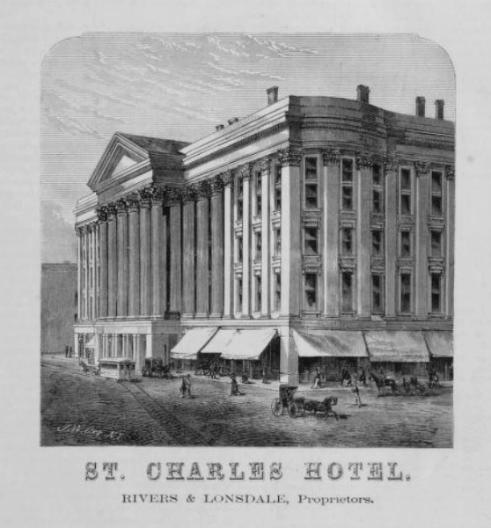
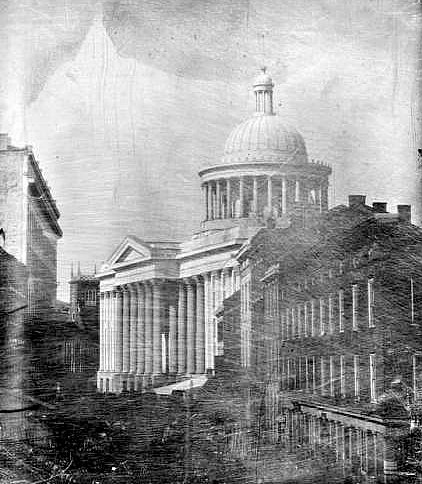
| Photo of the first St. Charles Hotel, 1847; thanks to Fred Diegel. |
| Sketch of the second St. Charles Hotel, 1873; from Jewell's Crescent City Illustrated. |
